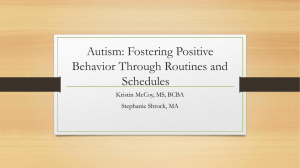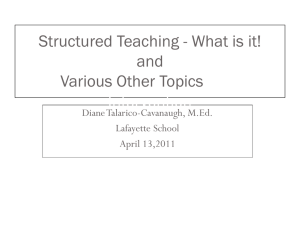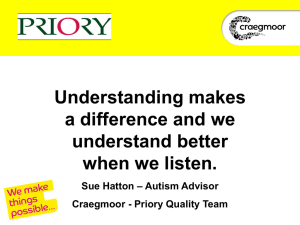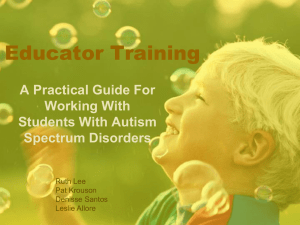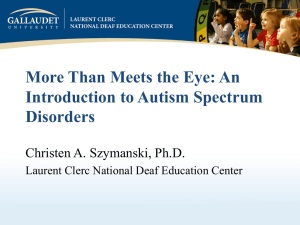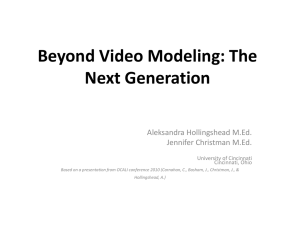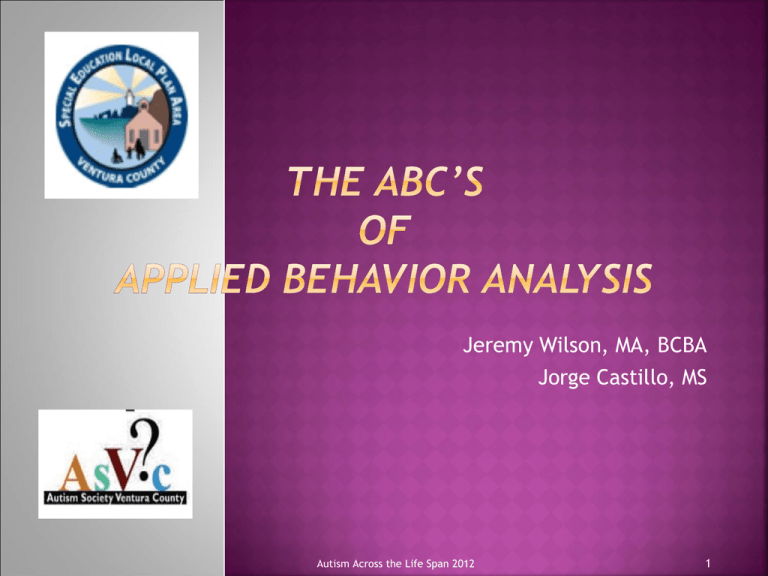
Jeremy Wilson, MA, BCBA
Jorge Castillo, MS
Autism Across the Life Span 2012
1
Jorge
Castillo, MS
Jeremy Wilson, MA, BCBA
Now tell us a little about you…
Autism Across the Life Span 2012
2
The
History of Behavior Analysis
A’s
Skinner and Operant Condition
From animals to humans
Birth of Applied Behavior Analysis
The Behavior Analyst
Scientist Practitioner
Ethics and ABA
Collaborative Partnerships
Autism Across the Life Span 2012
3
The
Operant Conditioning
B’s
Three term contingency
Four term contingency
Reinforcement
Punishment
Functional Analysis of Behavior
S.E.A.T.
Barriers
Skill Acquisition
Autism Across the Life Span 2012
4
The
Behavior Reduction Programs
C’s
Maladaptive and Problematic
Baseline and Intervention
Skill Acquisition Programs
Behavior deficits
DTT, PRT, NLP, and NET
Autism Across the Life Span 2012
5
The
Parent/Teacher struggles and How ABA can help:
MO
Toileting
Food Selectivity
Quality of life
Work Completion
Inclusion, Mainstreaming, and Social Integration
And much more…
Questions?????
Autism Across the Life Span 2012
6
Autism Across the Life Span 2012
7
Lived
from 1904 – 1989
Composed various literary works about
science and human behavior
Seminal works include:
Behavior of Organisms (1938)
Walden Two (1948)
Science and Human Behavior (1953)
Verbal Behavior (1957)
Schedules of Reinforcement (1957)
Technology of Teaching (1961)
Beyond Freedom & Dignity (1971)
About Behaviorism (1974)
Autism Across the Life Span 2012
8
Skinner
discovered and provided further
research and analysis of “operant
conditioning”
Studies were conducted with rats and
pigeons
Discovered schedules of reinforcement can
be implemented to shape behavior overtime
Introduced scholarly world to the
“Experimental Analysis of Behavior” and
“Radical Behaviorism”
“Radical” is used here as meaning fundamental, essential,
and thorough
Autism Across the Life Span 2012
9
Behavior is determined by the environment
Operant behavior affects the environment and generates
stimuli which “feeds back” to organism
Emphasis on the consequence of a behavior
Consequences can either increase or decrease probabilities
of behavior in the future
Contingencies of reinforcement
“The dynamic characteristics of our behavior depend upon
the actual schedules of reinforcement” (Skinner, 1957)
Autism Across the Life Span 2012
10
“If we are to use the methods of science in the field of
human affairs, we must assume behavior is lawful and
determined” (Skinner, 1953)
One of the first studies where the principles of operant
behavior was applied to a human behavior was in 1949.
The participant was a boy with “profound developmental
delays” (Fuller, 1949)
The science became more concerned about socially
significant behaviors and the uses of operant conditioning,
hence the birth of applied behavior analysis in 1968
Autism Across the Life Span 2012
11
Some Current Dimensions of Applied Behavior Analysis
(Baer, Wolf, & Risley, 1968)
Identified 7 dimensions of Applied Behavior Analysis (ABA)
Applied, Behavioral, Analytic, Technological, Conceptually
Systematic, Effective, Generality
If an intervention does not contain these 7 dimensions, it is not
considered to applied behavior analytic
It was quickly recognized that the overlap of the science of
behavior analysis and the application of behavior analysis
occurred within Applied Behavior Analysis and our practice
and primary focus of helping a specific situation or helping
people behave more successfully within those practices
needs to be guided by the principles our science was
founded on
Autism Across the Life Span 2012
12
The behavior analyst as a “scientist practitioner”
(Hayes, Barlow, & Nelson-Gray, 1999)
Consumer of evidenced based/empirically based
research
Evaluators of their own programs and
interventions using empirical methods
Researchers who produce data from their own
settings and disseminating that work to the
applied and scientific community
Autism Across the Life Span 2012
13
The Hippocratic Oath, “As to diseases, make a habit of
two things, to help, or at least do no harm”
The evolution of ethical considerations and guidelines for
behavior analysts began in the 1960’s with “behavior
modification” work shops which manipulated the ideals
and principles of our science
Behavior analysts soon developed a Code of Ethics and
developed governing board (BACB) which certifies
practicing behavior analysts
“…The guidelines of responsible conduct were developed
to assist the behavior analyst in making the right choices
on a daily basis” (Bailey and Burch, 2005)
Autism Across the Life Span 2012
14
“Behavior analysts have not been known to play nice in
the sand box” (Youngbauer, 2011; Personal
Communication)
There has somewhat been a negative learning history
associated with behavior analysts as practitioners
Behavior analysts are willing to forge collaborative
partnerships with other professionals, as long as these
relationships do not lead us to breach our ethics and
scientific principles that result in harming ourselves and
those we support
Expect the behavior analyst to be skeptical, to want
empirical evidence, and to make well calculated and
thought out decisions
Autism Across the Life Span 2012
15
“…behavior of an organism is that portion of an organism’s
interaction with it’s environment that is characterized by
detectable displacement in space through time of some
part of the organism and that results in a measureable
change in at least one aspect of the environment.”
(Johnston and Pennypacker, 1993)
Simply, behavior should be observable and measureable
Behavioral events are temporal
Autism Across the Life Span 2012
16
Antecedent
Behavior
Consequence
See the cookies
eat the cookies
cookies because they are so yummy!
being full of
* Behavior that is reinforced, increases the likeliness of
that behavior occurring again
Autism Across the Life Span 2012
17
MO
Antecedent
Behavior
Consequence
Hungry for cookies see the cookies eat the cookies
being full of cookies because they are so yummy!
** Here, the organism’s behavior is operating on a state
of deprivation (hunger) or an Motivating Operation
Autism Across the Life Span 2012
19
POSITIVE
(apply)
NEGATIVE
(remove)
REINFORCEMENT
(increase)
PUNISHMENT
(decrease)
POSITIVE REINFORCEMENT
The application of a stimulus
that will serve to increase
the likelihood of future
occurrences of the preceding
behavior.
POSITIVE PUNISHMENT
The application of a stimulus
that will serve to decrease
the likelihood of future
occurrences of the preceding
behavior.
NEGATIVE REINFORCEMENT
The removal of an aversive
stimulus that will serve to
increase the likelihood of
future occurrences of the
preceding behavior.
NEGATIVE PUNISHMENT
The removal of a stimulus
that will serve to decrease
the likelihood of future
occurrences of the preceding
behavior.
Primary and Secondary Reinforcing Stimuli
There are two varieties of reinforcing stimuli: primary
reinforcing and secondary reinforcing stimuli.
Primary reinforcing stimuli (SR) are unconditioned,
that is they are events or rewards whose value we
intrinsically realize: food, water, sex, warmth, etc.
The use of primary reinforcement has a few advantages
Primary reinforcement is intrinsic; it does not have to be taught.
Primary reinforcement will not extinguish, it will always remain
reinforcing. One will always desire food or water.
Primary reinforcement has some disadvantages
Primary reinforcers are subject to satiation after a relatively short
period of time.
Primary reinforcement is not especially representative of the
natural environment.
Secondary reinforcing stimuli (Sr) are conditioned.
These are initially neutral stimuli that, through their
association with primary, or other secondary
reinforcing stimuli, have become reinforcing.
Social praise, tokens
Conditioned reinforcers are typically more convenient to
use than primary.
Secondary reinforcement lessens the need for proximity to
a child.
Secondary reinforcement can be used to broaden the
interests of the child
Using a token economy system can increase the length of
time between presentation of reinforcers, allowing for
longer periods of instruction, with fewer interruptions, and
a lessened likelihood of satiation
Ratio
schedules
Fixed
ratio
Reinforcers given after a certain number of responses
Variable
Reinforcers given after approximate number of
responses
Interval
Fixed
schedules
interval
Reinforcers given after a certain interval of time
Variable
ratio
interval
Reinforcers given after an approximate range of time
intervals (ex: after about every 3 minutes)
What
is Punishment?
The introduction or removal of a stimulus that is
delivered after a behavior that reduces the
future frequency of the behavior
Function
of the Behavior
It is important to determine the function of the
inappropriate behavior
Once the function of the inappropriate behavior
is determined, an appropriate replacement
behavior can be taught
Type
I punishment that requires physical
contact should only be used under the most
extreme instances on inappropriate behavior
Fair Pair Rule
Any behavior that is reduced must be replaced
with an appropriate replacement behavior
Always
use the least to most intrusive forms
of punishment that are proven to be
effective
Consistently prompt and reinforce
alternative behaviors
Factors
to keep in mind when implementing
a punishment procedure
Immediacy of punishment
Schedule of Punishment
Continuous vs intermittent
Intensity of punishment
Immediate vs delayed
The more intense the punishing stimulus is, the
greater its effect on reducing the behavior
Reinforcing an suitable alternative behavior
Reinforcing a replacement behavior will also decrease
instances of the target behavior
Punishment
can be considered unethical
Informed consent from the client or the
parent/guardian is necessary before administering
a punishment procedure
Less intrusive or aversive interventions must be
shown to be ineffective
Making sure the punishment procedure has no
detrimental effect on the safety or well being of
the child
Data collection to determine punishment’s
effectiveness
Proper training for implementation and written
behavior plan
“…behavior of an organism is that portion of an organism’s
interaction with it’s environment that is characterized by
detectable displacement in space through time of some
part of the organism and that results in a measureable
change in at least one aspect of the environment.”
(Johnston and Pennypacker, 1993)
Simply, behavior should be observable and measureable
Behavioral events are temporal
Autism Across the Life Span 2012
28
“Our “independent variables” - the causes of behavior –
are the external conditions of which behavior is a
function” (Skinner, 1953)
Today, the functional analysis is a scientific methodology
which controls and manipulates environmental variables
to assess and identify behavior functions (Iwata et al,
1992)
Four functions of behavior (S.E.A.T.)
Here “independent variables” is in reference to antecedent
conditions and reinforcement/punishment procedures
S: Sensory or Behavior Maintained by Automatic Reinforcement
E: Escape/Avoidance (Sr-)
A: Attention (Sr+)
T: Tangible (Sr+)
Primarily used for problem/maladaptive behavior
Autism Across the Life Span 2012
29
The
behavior analyst is gathering empirical
evidence for each behavior
Conducts a descriptive analysis (Antecedents,
Behaviors, and Consequences)
Uses indirect measures
Functional Analysis Screening Tool (FAST)
Questions About Behavior Function (QABF)
The
behavior analyst analyzes all data, then
determines the function
*The functions of both desired and undesired
behavior should be analyzed
Autism Across the Life Span 2012
30
Often
times behaviors are barriers to the
acquisition or maintenance of desired
behaviors
We observe this fact in many of our behavior
intervention programs in the home and
school settings
Once we assess the behavioral barriers, we
can then develop an intervention to
“reduce” those barriers
Autism Across the Life Span 2012
31
CPC
Interventionist
We record
data on the
Bx to find out
if these are
working or
not…
Although each individual is different, the following characteristics are viewed as important in the diagnosis
of autism:
Communication (Verbal & Non-Verbal)
Pronoun reversal-Children refer to themselves as "he," "she," or "you," or by their own proper
names.
Social Interaction
Echolalia-repetitions of words or phrases previously heard.
Lack of Joint attention is the process by which one alerts another to a stimulus via nonverbal
means, such as gazing or pointing
Poor eye contact
Doesn’t respond to social cues
Repetitive behaviors or interests
Stereotypy is repetitive movement, such as hand flapping, making sounds, head rolling, or body
rocking.
Compulsive behavior is intended and appears to follow rules, such as arranging objects in stacks or
lines.
Sameness is resistance to change; for example, insisting that the furniture not be moved or
refusing to be interrupted.
Ritualistic behavior involves an unvarying pattern of daily activities, such as an unchanging menu
or a dressing ritual.
Restricted behavior is limited in focus, interest, or activity, such as preoccupation with a single
television program, toy, or game.
Self-injury includes movements that injure or can injure the person, such as eye poking, skin
picking, hand biting, and head banging.
Autism Across the Life Span 2012
35
The focus is to examine functions (causes) of behavior to
offer function based interventions (Kazemi, 2008).
If the undesired behavior is maintained by
attention (Sr+), then we need to use attention to
increase desired behavior and reduce undesired
behaviors
The intervention may be as simple as providing
attention while the child is engaged in
appropriate or desired behavior
Catching them being good!!!
Autism Across the Life Span 2012
36
Every behavior reduction program should include the
following protocols:
Reactive Strategies
Proactive Strategies (Antecedent Interventions)
Means to teaching alternative/replacement
behaviors
Every behavior reduction protocol should have signed
consent to prior to implementation
Every behavior reduction protocol should use and exhaust
all differential reinforcement procedures before utilizing
aversives or punishment procedures
Autism Across the Life Span 2012
37
In reference to the behavioral characteristics of children
with ASD, what are the behavioral deficits or non-existent
behaviors and what can we do to improve those
circumstances
Assessment includes direct observation and interaction
with individual
Indirect methods – questionnaires
Often times simple to complex behaviors are behaviors are
targeted
Programs should be purposeful, functional, and reflect a
scaffolding of skills without leaving gaps
Interventions should meet the 7 dimensions of ABA
Autism Across the Life Span 2012
38
Whether
it is DTT, PRT, NET, VBA, or XYZ, the
intervention should meet the 7 dimensions of
ABA and utilize the principles of applied
behavior analysis
Programs should utilize reinforcement
procedures to increase skills
Those who implement skill acquisition need
to remember that 50% of our technology is
reinforcement, the other 50% is punishment.
Hence, if we are not reinforcing behaviors,
we are punishing them…
Autism Across the Life Span 2012
39
The
behavior analysts role is to assess,
develop, train, monitor, record, analyze, and
report on your child’s programs
The behavior analyst makes data based decisions
The behavior analyst monitors the treatment
fidelity
The behavior analyst will use research to develop
intervention programs
The behavior analyst will tell, show, do, and
coach interventionists/parents through
implementing interventions
Autism Across the Life Span 2012
40
Autism Across the Life Span 2012
41
Autism Across the Life Span 2012
42
Toileting
Food
Selectivity
Sustainable Societies
School Attendance
Group Contingencies
Community Integration
Inclusive Practices
Staff Training
Autism Across the Life Span 2012
43
Autism Across the Life Span 2012
44
Autism Across the Life Span 2012
45

